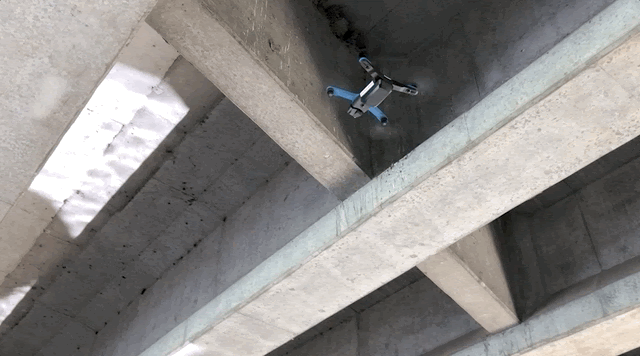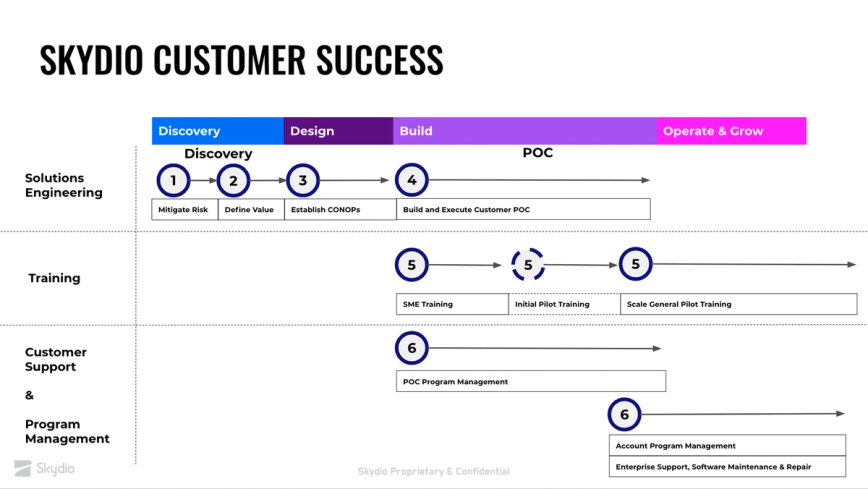For those of you that missed it, Skydio recently hosted a webinar in partnership with our friends at Commercial UAV News. The webinar, named “Inspection at Scale — How to Build a Mission-Critical Drone Inspection Program”, featured Alden Jones, Sr. Director of Customer Success at Skydio , Ben Spain, UAS Program Manager for the North Carolina Department of Transportation, and myself discussing the Skydio solutions and services that are helping customers (such as NCDOT) safely and efficiently scale their drone programs.
Danielle Gagne, Editorial Analyst at Commercial UAV News, created the following article that nicely summarizes the content and framework presented at the webinar, and kindly agreed to share it with our Skydio blog audience. Thanks Danielle! I still encourage you to take a look a the actual webinar to listen to the wealth of knowledge that industry-veterans Alden and Ben shared, but if you are time constrained or simply more of a reader, this is for you. The original article is posted here.

Solving the challenge of bringing drone operations to scale has been the holy grail for many in the industry. A lot goes into this process to get buy-in and funding from executives and regulatory institutions with a lot of that revolving around being able to demonstrate multiple levels of safety and security, value, and performance metrics. And all of this usually has to happen before a program even gets started.
Let’s take bridge inspections as an example. Traditional bridge inspection can be dangerous and expensive as well as disruptive to traffic. Usually, a team of bridge inspectors have to be lowered down over the side of a bridge either by rappelling on ropes from the top of the bridge or being lowered down with a piece of equipment called a snooper truck — an expensive vehicle that requires a large crew to operate and poses safety risks to the operators.
Drones have been looked at as a potential solution for a while now, but there have been some challenges. First, bridges interfere with GPS, which many drones rely on for navigation. Second, bridge inspections require complex flight maneuvers that could lead to crashes, which means that organizations need to invest heavily in training to try to mitigate this risk. Third, because the goal is to keep operators from having to go under the bridge and risk their lives, these drones need to be able to operate beyond visual line of sight (BVLOS) without a visual observer in order to truly realize their value.
During a recent webinar, “Inspection at Scale — How to Build a Mission-Critical Drone Inspection Program,” Alden Jones, Senior Director of Customer Success at Skydio broke down the steps that Skydio recommends to build a successful drone inspection program at scale, which are the following:
- Perform risk assessments
- Define the value of data
- Set CONOPS and understand regulation
- Proof of concept
- Train & Expand
- Sustain the program
Understanding this roadmap can make the difference between growing your operation successfully or not. So, when Skydio teamed up with North Carolina Department of Transportation (NCDOT) for their bridge inspection operations, they understood the importance of these initial first steps and how it would affect their ability to scale.
NCDOT chose Skydio as its partner and the Skydio 2 as the solution to scale their bridge inspection operation in a safer, cheaper, and more efficient way. The result of the partnership was a first-of-its-kind blanket waiver from the FAA to fly BVLOS without a visual observer in class-G airspace, which will enable NCDOT to scale their bridge inspection operations throughout North Carolina.

Let’s review Skydio’s guidelines to scale a successful drone inspection program in more detail.
Perform Organization-Level Risk Assessments
Before any program can get off the ground or grow, companies need to understand the risk and liability involved and they need to understand what measures can be put into place to reduce or eliminate those risks.
“Oftentimes, what stops organizations from taking that next leap is the threat of lawsuits due to crashes,” stated Jones. “It’s really important to understand when you go to an executive or program leader you need to show them how you are going to mitigate risk. We did a survey with over 100 different organizations and drone crashes were the biggest concern, because no matter how much ROI you have in the program, all of that can get wiped away by a large lawsuit. Even if there is 1% or 2% chance, your executives are going to think about that and wonder if it is really worth it for them.”

This is one of the reasons that the industry has been developing technology for fully autonomous flights. When drones are flown manually, the risk of a crash is greater than when flown by autonomous drones, like the Skydio 2 or Skydio X2 . There are several reasons for this.
One of the reasons is that the skill and attention of the drone pilot is a factor. For example, if someone is still new at flying, or if a skilled pilot is operating tired or distracted. In contrast, a Skydio drone flying with proven autonomy technology will fly in a safe and predictable manner while ensuring full obstacle avoidance to ensure the integrity of the vehicle as well as the safety of operators and potential bystanders.
Once you can mitigate potentially costly risks that could impact your return on investment, you can begin to define what the value is for your organization.
Define the Value of the Data
There are a lot of things drones are capable of doing, and all that capability can be overwhelming at first. But this is where some programs get caught up. In that initial phase, they focus too broadly on all the use cases rather than solving a particular problem within their organization that is really going to drive value.
“Drones are basically a flying sensor,” stated Jones. “At the end of the day, the imagery or data that you capture with those sensors is what really drives value to your program. Drones can do a lot of things, but my recommendation is to focus on a few things that you do that are dangerous, time consuming, or expensive and focus on these to drive value. Find things that cause pain now and solve those issues completely with drones. By focusing on these few issues rather than all the things drones can do, it will be easier to expand and scale up.”
For example, Skydio and NCDOT defined where the pain points were for a specific type of operation, bridge inspection, and then identified the value that Skydio’s autonomous technology could bring, namely, autonomous flight in GPS denied environments.
“Once you learn your barrier to entry in terms of how you can scale, your program changes dramatically,” explained Jones.
Beyond what drones can do and the value they can bring, they need to meet regulatory safety requirements.
Set CONOPS and Understand Regulation
When thinking about your concept of operations (CONOPS) and when trying to understand the regulatory landscape, Jones promotes thinking about this in an aggregated way, that is, your entire portfolio rather than just one individual mission or place. For example, where are your assets? Are most of them in the middle of nowhere or do you have more in controlled airspace? This will determine the regulatory requirements you will have to meet and whether or not you’ll get the FAA clearance you need to manage all of your assets.
Currently, there is no checklist that defines what will and will not be approved by the FAA. Most of the time these waivers are given because agencies are able to prove a solid safety case. As hardware and software platforms are approved for advanced operations, this is opening the door for businesses to get the waivers they need to realize value. In the case of NCDOT, the key to obtaining the blanket regulatory waiver for bridge inspections was directly linked to the Skydio 2’s ability to fly autonomously in GPS denied environments.
“We just received a waiver from the FAA to fly beyond line of sight without a visual observer underneath any bridge in North Carolina that are outlined within the waiver,” said Ben Spain, UAS Program Manager of the North Carolina Department of Transportation. “This is a huge relief to our pilots. This is due to the Skydio platform, the FAA recognized the capabilities of their drone to fly safely underneath bridges while maintaining solid navigational performance, even in GPS denied environments. Our waiver is tied to the Skydio 2.”
Proof of Concept, Training and Expanding, and Sustaining the Program
Proof of concept is really about defining the metrics that will define the success for your team and the organization — it is how you can show your organization that you can get a return on investment. The key to defining appropriate metrics is with education — you need to know enough about your processes, the data being produced, and the technology being used to understand how your team can define, measure, and validate metrics for success.
“Proof of concept is very much in Skydio’s DNA, and it is something we want to do to ensure that you’re successful,” said Jones. “And this translates directly into training. We can help you with detailed familiarization training so that your proof of concept is successful.”
Beyond this initial education and training, when looking at a platform or software, it is important to think about its longevity. How will the platform adapt to the needs of the company as it matures? Understanding the services and roadmap for the future is essential to ensuring you are selecting partners that will grow with you. No one wants a product that will be obsolete in two years. Companies like Skydio understand that this is a key element to helping companies and agencies scale.

“Understanding the product is obviously key, but it doesn’t just end with Q&A and technical questions to the support team,” Jones explained. “We want to support you in a scalable enterprise throughout the lifecycle of the system.”
Each of these steps are important and integral to ensuring your drone program will not only scale in the short-term but will have the longevity and viability for years to come.



